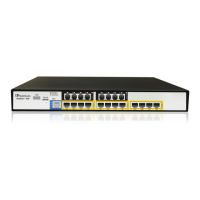Parameter Description
Authentication Type
CLI: authentication-type
[NFSServers_AuthType]
Authentication method used for accessing the remote file system.
[0] Null
[1] Unix (default)
User ID
CLI: uid
[NFSServers_UID]
User ID used in authentication when using Unix.
The valid range is 0 to 65537. The default is 0.
Group ID
CLI: gid
[NFSServers_GID]
Group ID used in authentication when using Unix.
The valid range is 0 to 65537. The default is 1.
VLAN Type
CLI: vlan-type
[NFSServers_VlanType]
The VLAN type for accessing the remote file system.
[0] OAM
[1] MEDIA (default)
Note: This parameter applies only if VLANs are enabled or if Multiple
IPs is configured (see 'Configuring IP Network Interfaces' on page
113).
14.6 Network Address Translation Support
Network Address Translation (NAT) is a mechanism that maps internal IP addresses (and
ports) used within a private network to global IP addresses and vice versa, providing
transparent routing to end hosts. The primary advantages of NAT include (1) reduction in
the number of global IP addresses required in a private network (global IP addresses are
only used to connect to the Internet) and (2) better network security by hiding the internal
architecture.
The design of SIP creates a problem for VoIP traffic to pass through NAT. SIP uses IP
addresses and port numbers in its message body. However, the NAT server is unable to
modify the SIP messages and thus, can’t change local addresses to global addresses.
This section discusses the device's solutions for overcoming NAT traversal issues.
14.6.1 Device Located behind NAT
Two different streams traverse through NAT - signaling and media. A device located
behind a NAT, that initiates a signaling path has problems receiving incoming signaling
responses as they are blocked by the NAT server. Therefore, the initiating device must
inform the receiving device where to send the media. To resolve this NAT problem, the
following solutions are provided by the device, listed in priority of the selected method used
by the device:
a. If configured, uses the single Static NAT IP address for all interfaces - see 'Configuring
a Static NAT IP Address for All Interfaces' on page 132.
b. If configured, uses the NAT Translation table which configures NAT per interface - see
Configuring NAT Translation per IP Interface on page 133.
If NAT is not configured by any of the above-mentioned methods, the device sends the
packet according to its IP address configured in the Multiple Interface table.
Note: The priority list above is applicable only to the Gateway/IP-to-IP application.

